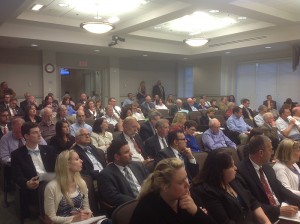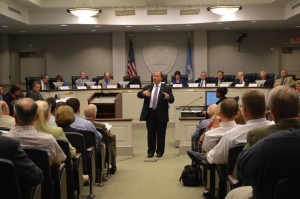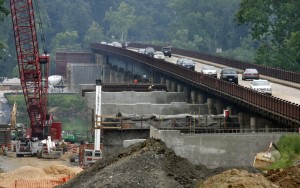During a meeting last month in Falmouth, a Virginia Department of Transportation official was asked a probing question about the Interstate 95 express-lanes project.
Rupert Farley of Spotsylvania County wanted to know what would happen if the high-occupancy toll lanes attract so many vehicles that are allowed to use them free that the company building them doesn’t recoup the money it expects.
“Maybe you can refresh my memory on a point that you did not bring up tonight,” started Rupert Farley, a Spotsylvania resident well known in transportation circles. “If this project is so widely successful that it gets used …by HOV free [traffic], that means Fluor[–Transurban] doesn’t get any income and they start losing money.“At that point, do the taxpayers of Virginia have to start kicking in out of their pockets to subsidize the project?” asked Farley, who is a member of the Fredericksburg Area Metropolitan Area Planning Organization’s Transportation Advisory Group.
“No,” said Toymeika Braithwaite, VDOT Megaproject’s express lanes public affairs manager.
“That’s not what I’ve been told,” said Farley, who is also a member of the Fredericksburg Area Metropolitan Area Planning Organization’s Transportation Advisory Group.
“If Transurban doesn’t make the money they want to make, it is not up to Virginia taxpayers to subsidize that,” said Toymeika Braithwaite, VDOT Megaproject’s express-lanes public affairs manager.
However, the public–private project contract signed with Transurban Group and Fluor Corp. includes stipulations that could force Virginians to pay the companies if non-toll-paying HOV traffic reach certain thresholds.
The threshold is based on a complicated formula comparing the percentage of free HOV traffic to toll-paying drivers. If the HOV traffic reaches the threshold, the state has to pay the companies 70 percent of the toll rate.
That agreement is no secret; it’s in the contract, which has been online since the summer of 2012.
But those details have flown under the radar since the state struck the deal with Transurban and Fluor on the massive I–95 express-lanes project. And those who attended that October meeting in Stafford County likely had no idea about that part of the contract, which is what Farley was alluding to.
Under the agreement, the companies are paying for most of the nearly $1 billion project, which will extend the current HOV lanes in the median of I–95 to Garrisonville.
State officials have said that without the agreement the express lanes wouldn’t have been built because the state funds weren’t available.
The same has been said of the Interstate 495 express lanes, which have been open for more than a year. The state has the same deal with Transurban and Fluor on those new lanes.
The I–95 express lanes are on target to open by early 2015.
Like the I–495 express lanes, the new I–95 lanes will be electronically tolled. Buses, motorcycles and vehicles carrying at least three people will be able to use them for free.
The companies hope to take in the toll revenues from other motorists and use them first to pay off loans used to build the projects.
After that, the companies hope to ring up profits. The state eventually would also get a percentage of any profits.
Usage of the lanes is no guarantee, though.
The I–495 express lanes, for instance, haven’t drawn much traffic so far. While it was expected to take up to three years for traffic to consistently use the I–495 lanes, thus far they haven’t produced the traffic, or revenue, Transurban expected.
With constant congestion problems on I–95, it’s a good bet drivers who don’t qualify to use free HOV lanes will be open to paying a toll in order to move.
Still, there could be a significant amount of HOV commuter traffic using the lanes. And the more free traffic there is on the express lanes, the lower the profit.
VDOT doesn’t think there will be a problem.
Tamara Rollison, VDOT’s division administrator of communications, said in an email that the companies bear the “risk of traffic volume and revenue. VDOT is not responsible for making up any shortfall that may occur if traffic volume and revenue are below 95 Express’ forecasts.”
She acknowledged the agreement on the HOV threshold, but said it is unlikely to be met.
“Should that happen—VDOT is prepared to compensate 95 Express Lanes LLC,” she said. “While we expect HOV use to grow over time, we don’t think it will climb to the point that the threshold will be exceeded, triggering compensation.”
If HOV traffic does exceed the threshold, Rollison said that would mean the lanes would be “moving tremendously more people than ever expected, which would greatly help ease congestion on the general purpose lanes.”
Another part of the I–95 express-lanes project includes the expansion of bus service and the addition of 3,000 new commuter parking spaces along the corridor.
Despite the benefits of the project, there are still critics of the public–private deals for the express lanes.
Farley is a fan of toll roads, especially those that manage congestion like the express lanes are designed to do.
But he thinks the state got a raw deal.
“It’s unconscionable that they’d sign a contract so one-sided,” he said.
Stewart Schwartz, executive director for Coalition for Smarter Growth, also doesn’t like the express lane deals.
“We have long argued that the closed-door deals by VDOT under the Public–Private Transportation Act for the HOT lanes have compromised good planning, prevented effective analysis of alternatives, and failed to evaluate all of the impacts,” he said in an email. “In addition, the requirement that the taxpayer reimburse the private toll road operator for too many HOV users is counter to the goal we should have of moving more people in the peak hour. In fact, instead of encouraging HOV use, at a certain point VDOT will now have an incentive to discourage HOV use.”
Peter Samuel, who writes for the website TollRoadsNews.com, doesn’t see the express lanes as such a bad deal.
“I don’t think it’s too risky,” he said. “I doubt there’s going to be a huge increase in carpooling.”
He believes the companies are taking the bulk of the risk. If the express lanes aren’t profitable, they lose, not the state.
Transurban has already experienced failure with another Virginia toll road.
The Australia-based company lost more than $100 million on the Pocahontas Parkway, Interstate 895, according to TollRoadsNews and other reports.
The toll road failed to generate enough money to cover Transurban’s debt, and earlier this year a consortium of European banks holding that debt became the state’s new partner with the toll road.
Officials said the change wouldn’t affect the toll-road operations.
Regardless of the Pocahontas Parkway problems, Samuel says the I–95 express lanes will be a “good thing for motorists.”
“It gives them another option,” he said. “How well it’ll work out for the investors is another question.”
The same could be said for Virginia taxpayers.




